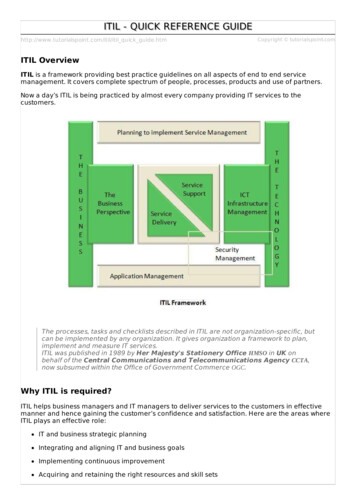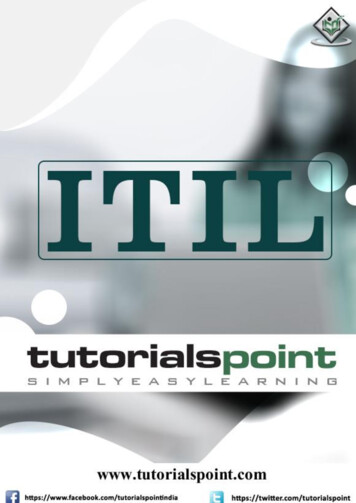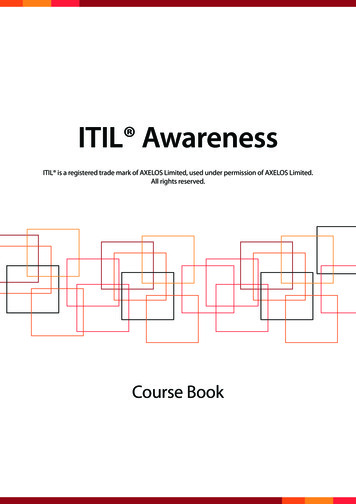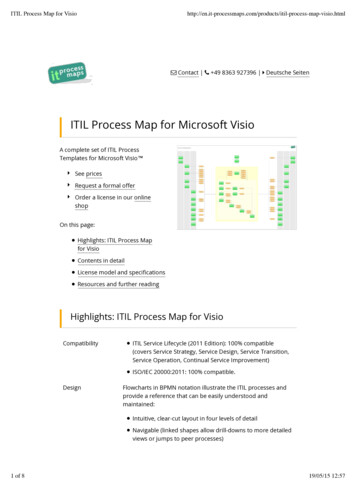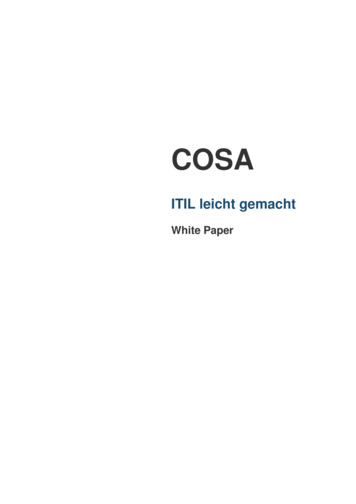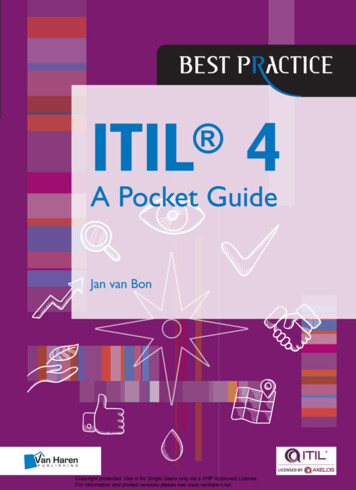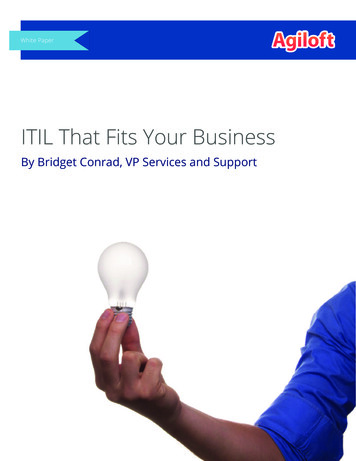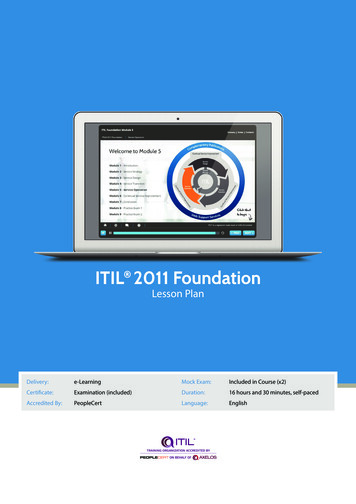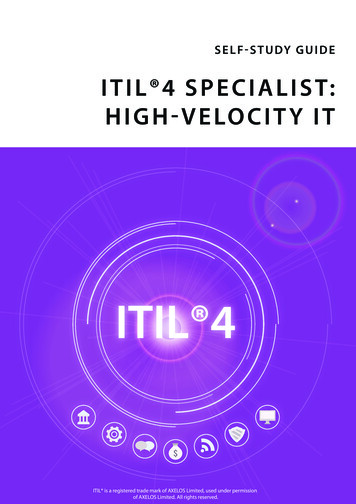
Transcription
S e l f - S t u dy G u i d eI T I L 4 S p e c i a list:H i g h - V e lo c it y I TITIL 4ITIL is a registered trade mark of AXELOS Limited, used under permissionof AXELOS Limited. All rights reserved.
Copyright and DisclaimerSelf-Study Guide ITIL 4 Specialist: High-Velocity IT r1.0.0CopyrightCopyright AXELOS Limited 2020. All rights reserved.This is a commercial confidential publication. All rights reserved. This document may not, in a whole orin part, be copied, reproduced, translated, photocopied, or reduced to any medium without prior andexpress written consent from the publisher. This course includes copyrightable work under license andis protected by copyright. No part of this publication may be reproduced, distributed, or transmittedin any form or by any means, including photocopying, recording, or other electronic or mechanicalmethods, without the prior written permission of the publisher, except in the case of brief quotationsembodied in critical reviews and certain other non-commercial uses permitted by copyright law orfurther disseminated without the express and written permission of the legal holder of that particularcopyright. The Publisher reserves the right to revoke that permission at any time. Permission is notgiven for any commercial use or sale of this material.Trade Marks, Source books informationThe content of this book is primarily sourced from the draft version of the AXELOS manuscript forITIL 4 Specialist: High-Velocity IT.The content of this course is also sourced from other manuscripts from AXELOS: ITIL Foundation (ITIL 4 edition) ITIL 4 Specialist: Create, Deliver and Support ITIL 4 Specialist: Drive Stakeholder Value ITIL 4 Strategist: Direct, Plan and ImproveITIL is a registered trade mark of AXELOS Limited, used under permission of AXELOS Limited. Allrights reserved.DisclaimerInformation provided about the course, modules, topics and any services for courses includingsimulations or handouts, are an expression of intent only and are not to be taken as a firm offer orundertaking. The Publisher reserves the right to discontinue or vary or maintain such course, modules,topics, or services at any time without notice and to impose limitations on enrolment in any course.The course materials provided may have hypertext links to a number of other web sites as a referenceto users. This service does not mean that the publisher endorses those sites or material on them inany way. The publisher is not responsible for the use of a hypertext link for which a commercial chargeapplies. Individual users are responsible for any charges that their use may incur.The information in this course is written using a blend of British and American English. Although everyeffort has been made regarding the usage of correct spelling, punctuation, vocabulary, and grammarwith regard to the Standard English, publisher accepts no responsibility for any loss or inconveniencecaused due to the regional differences in the usage of the English language.ii
ContentsAcknowledgements vIIModule 1: Course Introduction1Course Overview1Course Learning Objectives2Target Audience2Characteristics2ITIL 4 Certification Scheme3Course Components3Module-End Exercises4Exam Details4Module 2: Introduction to High-Velocity IT5Key Terms Covered in the Module5Module Learning Objectives6Topics Covered6High-Velocity IT6Digital Technology9Digital Organizations12Digital Transformation15Module-End Exercise18Summary Key Points19Module 3: High-Velocity IT Approaches21Key Terms Covered in the Module21Module Learning Objectives21Topics Covered21Relevance of High-Velocity IT Approaches22High-Velocity IT Approaches in Detail26Module-End Exercise34Summary Key Points34Module 4: High-Velocity IT Operating Models35Key Terms Covered in the Module35Module Learning Objectives36Topics Covered36Introduction36Itil Perspective39High-Velocity IT Aspects42High-Velocity IT Applications45Module-End Exercise50Summary Key Points50Module 5: ITIL Building Blocks for High-Velocity IT53Key Terms Covered in the Module53Module Learning Objectives54Topics Covered54Digital Product Lifecycle54Service Value Streams59Copyright 2020 iii
Four Dimensions of Service Management61Four Dimensions of Service Management62Itil Management Practices67Module-End Exercise72Summary Key Points73Module 6: High-Velocity IT CultureKey Terms Covered in the Module75Module Learning Objectives75Topics Covered75Key Behavior Patterns76ITIL Guiding Principles80Module-End Exercise86Summary Key Points86Module 7: Supporting Models and Concepts for Purpose87Key Terms Covered in the Module87Module Learning Objectives88Topics Covered88Ethics88Design Thinking96Module-End Exercise99Summary Key Points99Module 8: Supporting Models and Concepts for People101Key Terms Covered in the Module101Module Learning Objectives101Topics Covered102Reconstructing for Service Agility102Safety Culture107Stress Prevention110Module-End Exercise115Summary Key Points116Module 9: Supporting Models and Concepts for Progress117Key Terms Covered in the Module117Module Learning Objectives118Topics Covered118Working in Complex Environments118Lean Culture125ITIL Continual Improvement Model129Module-End Exercise136Summary Key Points136Module 10: High-Velocity IT Objectives and Techniquesiv75139Key Terms Covered in the Module139Module Learning Objectives140Topics Covered140High-Velocity IT Objectives140High-Velocity IT Techniques143Module-End Exercise147Summary Key Points147 Copyright 2020
Module 11: Techniques for Valuable Investments149Key Terms Covered in the Module149Module Learning Objectives149Topics Covered150Valuable Investments – The Measurement Criteria150Valuable Investments – Need and Benefits151Digital Product Lifecycle and Potential Value Realization152Prioritization Techniques152Minimum Viable Products and Services155Product/Service Ownership159A/B Testing162Module-End Exercise166Summary Key Points166Module 12: Techniques for Fast Developments169Key Terms Covered in the Module169Module Learning Objectives170Topics Covered170Basic Concepts Related to Fast Development170Infrastructure as Code173REVIEWS177Continual Business Analysis181Continuous Integration / Continuous Delivery (CI/CD)184Continuous Testing187Kanban191Module-End Exercise194Summary Key Points194Module 13: Techniques for resilient Operations197Key Terms Covered in the Module197Module Learning Objectives197Topics Covered198Introduction to Resilient operations198Technical Debt200Chaos Engineering203Definition of Done208Version control212Algorithmic IT Operations214ChatOps217Site Reliability Engineering (Sre)220Module-End Exercise225Summary Key Points225Module 14: Techniques for Co-created Value227Key Terms Covered in the Module227Module Learning Objectives227Topics Covered227Basic concepts of co-created value228Service experience230Module-End Exercise234Summary Key Points234Copyright 2020 v
Module 15: Techniques for Assured Conformance235Key Terms Covered in the Module235Module Learning Objectives235Topics Covered236Introduction to Assured Conformance236DevOps Audit Defense Toolkit237DevSecOps238Peer Review242Module-End Exercise245Summary Key Points246Exam Preparation Guide247Mock Exam251Appendix A: Syllabus297Appendix B: Release Notes307Appendix C: Participant Feedback Form309vi Copyright 2020
AcknowledgementsWe would like to sincerely thank the experts who have contributed to the design and development ofthe ITIL Specialist: High-Velocity IT course.Design TeamSimone Jo MooreSimone Jo Moore Simone is recognized as a leading industry thought leaderand is known as a “Service Management Mixologist” probing the hearts andminds of what makes business and IT tick to jumpstart people’s thinkingto evolve behavior and actions at any level. People connected, knowledgeshared, possibilities discovered, and potential realized are the active valuesthat Simone uses to help organizations build a resilient foundation for theirongoing transformation and digital journey.Simone is a contributing author to VeriSM Unwrapped and Applied, is a seniorconsultant, master trainer, author, podcast co-host, and mentor in variousframeworks such as BRM, ITIL, KCS, DevOps, and SFIA. Simone is a HDIFaculty member and on the International Certification Standards Committee(ICSC) as well as an ICMI Senior Contact Centre Manager.For the ITIL 4 Specialist: High-Velocity IT course, Simone participated as aLead Author in the design and development of core course components.Madeleine Du ToitMadeleine du Toit has been an active member of the IT Service Managementcommunity for over 20 years, of which 15 years are focused on training andconsulting different elements of the ITIL framework. She has been part ofand led several implementation projects within the IT Service Managementframework, with a key focus on practical governance for maximum benefit.Madeleine is an accredited trainer for all products within the ITIL v3 certificationscheme, she has assisted many thousands of people in getting their ITILFoundation and ITIL Expert accreditations.For the ITIL 4 Specialist: High-Velocity IT course, Madeleine participated asa co-author in the design and development of practice questions.Marcel FoedererAs an IT Service Management trainer, consultant and line manager with over25 years of experience in IT, Marcel has performed strategic and tacticalassignments in a wide variety of areas. For the ITIL 4 update, Marcel hasbeen part of the ITIL 4 Lead Architect Team and Review Team at AXELOS.Through his association with AXELOS, Marcel comprehends the background,the architecture, and the underlying reasons of the ITIL 4 update.Copyright 2020 vii
Self-Study Guide ITIL 4 Specialist: High-Velocity ITContributors and ReviewersA big thanks to the Contributors for their feedback, suggestion, and inputs.NameOrganizationAlfonso Figueroaausfigs@yahoo.com.auAlain Bonneaudalain@bonneaud.netAlejandro Canonalejandro.canon@outlook.comAlvaro tonis Argyridesantonisargyrides@gmail.comArmando Galeanaa@ubhuru.comAlfonso Figueroaausfigs@yahoo.com.auBalantrapu Roudrirowdri@dizitiveit.comCesar Gutierrezcesar.gutierrez@tohkin.com.mxDaniel Cabacodcabaco1972@gmail.comCarlo Rossicarlo.rossi@crconsultingnet.itCezary Krzeminskicezary.krzeminski@omec.plEdward Grayinfo@grayematter.netErdal-Erol Ibraimerol.ibraim@gmail.comGonzague Patiniergonzague.patinier@ppp-partners.comHamzeh Habibihamzeh.habibi@gmail.comHans-Jörgen Nilssonhans-jorgen@telia.comHristo Hristovhristo.hristov@servicecentrix.comIbrahim Yildirimibrahimy@live.comIvan Gasparovicitpreneurs@a7a7a7.comJohn Custyjpcgroup@outlook.comJoris Heirmanjoris.heirman@yokosix.comJorge Blancojorge@glumin.comJuan Carlos Landajclanda@llgconsult.comKimberly Morrisonkimberlydawn20@gmail.comLaszlo Czirokczirok.laszlo@mc3.huMaarten Bordewijkmaarten@bordewijk-training.nlMarkus Schweizermarkus.schweizer26@gmail.comMatiss Horodishtianog.matissh@gmail.comviii Copyright 2020
AcknowledgementsMaurits Baeyensmaurits.baeyens@dpm-services.euMohamed Roshdymshamel100@gmail.comMohammad Tawfiqmtawfiq.2010@hotmail.comPatricia Fridmanpatriciafridman@comunit.com.arNadjib Aithamoudinadjib.aithamoudi@pm-perspective.euOlena Hellerolena.heller@gmail.comPatricia Francezipfrancezi@idev.com.brPeter Gerritsenpeter.gerritsen@peppergroup.frPiotr Kotelnickip.kotelnicki@crm.com.plRoberto Riverarobrivera65@gmail.comRosario Fondacarorosario.fondacaro@outlook.comSadasivam Rengarajaskcoachsai@gmail.comSatish Medasatish@sysprocess.netStella Salas Sanchezalexandra.salas@ascal.com.coSteve Tremblaystevetremblay@fifalde.comSteve Johnsonstevejohnsonmcse@gmail.comSutthichai Preamsiriniransutt@ovthai.comTaqi Razastrnaqvi@hotmail.comThomas Fruinthomasfruin@artefactum.clTim Darbydarbytj@aol.comTony Arrowsmithagarrow@prosysint.com.auTsutomu Miyairimiyairits@gmail.comVirginia Araujovirginia.araujo@gmail.comWesley O’Moorewesleyo@cconza.com\Copyright 2020 ix
1Course IntroductionCourse OverviewThe ITIL 4 Specialist: High-Velocity IT course is based on the ITIL 4 Specialist High-Velocity IT candidate syllabus from AXELOS.The course addresses the specifics of digital transformation andhelps organizations to evolve towards a convergence of businessand technology, or to establish a new digital organization.With the help of ITIL 4 concepts and terminology, activities,exercises, and examples included in the course, you will acquirerelevant knowledge to pass the ITIL 4 Specialist: High-VelocityIT certification exam.The ITIL 4 Specialist: High-Velocity IT course is designedto enable practitioners to explore the ways in which digitalorganizations and digital operating models function in high-velocityenvironments. It will help aspiring organizations to operate in asimilar way to successful digitally-native organizations.The course includes the use of working practices such as Agileand Lean, and technical practices and technologies such as Cloud,Automation, and Automatic Testing. The focus of these practices andtechnologies is on the rapid delivery of products and services to obtainmaximum value.Copyright 2020 1
Self-Study Guide ITIL 4 Specialist: High-Velocity ITCourse Learning ObjectivesAt the end of the course, you will be able to:Understand concepts regarding the high-velocity nature of thedigital enterprise, including the demand it places on IT.Understand the digital product lifecycle in terms of the ITILoperating model.Understand the importance of the ITIL guiding principles andother fundamental concepts for delivering high-velocity IT.Know how to contribute to achieving value with digitalproducts.Copyright AXELOS Limited 2020. Used under permission of AXELOS Limited. Allrights reserved.Target AudienceThe course aims at IT and service management practitioners whowork in organizations that are becoming more digitally enabled.It will help those who are familiar with traditional IT and servicemanagement concepts to discuss ‘digital’ confidently, developpractical competencies, and integrate new concepts, techniques, andtechnologies into their ways of working.Based upon AXELOS ITIL materials. Material is used under licence from AXELOSLimited. All rights reserved.CharacteristicsImprovement Tool: You should use this course as a tool toimprove how you and your coworkers:{{Provide products and services{{Continually raise your standards of work{{Trust and are trusted{{Accept ambiguity and uncertainty{{Commit to continual learningDigital Value Chain: The course includes the primaryactivities in the digital value chain, including what thepractitioner does and the resources they use across thelifecycle of digital products to:{{{{2 Copyright 2020Make the right digital investmentsRealize and deliver resilient digital products and servicesquickly
Module 1 Course Introduction{{{{Ensure that the service consumer realizes value from thoseproducts and servicesAssure the conformance of activities with governance, risk,and compliance requirementsBased upon AXELOS ITIL materials. Material is used under licence from AXELOSLimited. All rights reserved.ITIL ITIL 4CertificationScheme4 Certification SchemeCopyright AXELOSLimitedUsed underpermissionAXELOSLimited.All rights reserved.Copyright 2019.AXELOSLimited2020. ofUsedunderpermissionof AXELOSrights reserved.Limited. AllCopyright 2020 6ITIL 4 Specialist: High-Velocity IT is one of the modules of the ITILManaging Professional (MP) stream. You need to pass the relatedcertification exam for working towards the Managing Professionaldesignation. Course ComponentsCourse mponentsCopyright 2020 3
Self-Study Guide ITIL 4 Specialist: High-Velocity ITLet’s discuss what each component contains.Course Modules: The course is divided into various modulesto explain the key concepts in a structured manner.Exam Information: The course contains Exam PreparationGuide and AXELOS Syllabus that will provide you with all therequired information related to the certification exam.Additional Components: The course also contains additionalcomponents to better prepare for your certification exam, suchas sample paper, practice questions, and glossary.Module-End ExercisesAt the end of each module, an exercise will be conducted to reinforcethe learning of concepts contained in that module. These exerciseswill be application focused and consists of different types of activities,such as group discussions, presentations, and brainstorming.Exam DetailsAt the end of the course, an exam will be conducted. The exam detailsare:Bloom Level: 2 and 3Exam Format:{{Close Book format{{Web-based and paper-basedQuestions: 40 Multiple Choice Questions (MCQs) of 1 markeachPassing Score: 70% (28 marks out of 40)Exam Duration:{{{{INFOSample PaperThe latest sample paper is includedin the course during its development.AXELOS might come up with a newerversion of sample paper.4 Copyright 202090 minutes25% extra time for non-native English speakers (113 minutesin total)Proctoring: Live/WebcamAfter completing this training, you will be planning to take the ITIL 4Specialist High-Velocity IT certification exam. To give you an ideaabout the certification exam, sample paper (or mock exam) is includedwithin the course.
2Introduction to HighVelocity ITKey Terms Covered in the ModuleHigh-Velocity IT is the application of digital technology for significant business enablement,where time to market, time to customer, time to change, and speed, in general, is crucial. It isnot restricted to fast development and is required from innovation through development andoperations to the actual realization of value.Digital Technology the technology that digitizes something or processes digital data, suchas text, sound, and images. Digitization is the process of transforming something from analogto digital form or expressing digital data in binary digits. Digital technology refers to digitizedInformation Technology (IT) and the parts of digitized Operational Technology (OT).Information Technology (IT) is the application of digital technology to store, retrieve,transmit, and manipulate data (data processing), often in the context of a business or otherkind of organization.Operational Technology (OT) is the application of digital technology for detecting or causingchanges in physical devices through monitoring or control or both.Digital Transformation is a process of using digital technology to enable a significantimprovement in realizing organizational objectives that are difficult to achieve feasibly throughnon-digital means.Digital Product is a product that an organization store and deliver in its electronic format,and the consumers receive and use these products electronically.Digital Service is the electronic delivery of information across multiple platforms and devices,for example, buying a physical product online.Based upon AXELOS ITIL materials. Material is used under licence from AXELOS Limited. All rights reserved.Copyright 2020 5
Self-Study Guide ITIL 4 Specialist: High-Velocity ITModule Learning ObjectivesAt the end of this module, you will be able to:Discuss the need and nature of high-velocity IT inorganizations.Explain digital technology and its primary components.Qualify an organization as digitally enabled.Explain transformation, digital transformation, and ITtransformation.Topics CoveredHigh-Velocity ITDigital TechnologyDigital OrganizationsDigital TransformationHigh-Velocity ITThe DefinitionHigh-Velocity IT is the application of digital technology forsignificant business enablement, where time to market, timeto customer, time to change, and speed, in general, is crucial.Based upon AXELOS ITIL materials. Material is used under licence fromAXELOS Limited. All rights reserved.What does having a high-velocity IT mean?Some digital organizations are more digital, and some are less.Likewise, some organizations have higher operating velocity thanothers. An organization having a higher velocity does not mean it willalways be having a positive impact on the business. The velocity atwhich an organization should operate depends on its nature. Someorganizations might require high velocity for its operations. However,for some organizations, a lower velocity can be beneficial. Therefore,high velocity cannot always be a better step. Organizations should nottry to have higher velocity just for the sake of matching the competitor’sstandards.Applying the high-velocity IT to the entire organization is not necessary.Let us consider an example of an organization that has dynamiccustomer-facing systems that require high-velocity IT way of workingfor their efficient management. On the other hand, its back-office has6 Copyright 2020
Module 2 Introduction to High-Velocity ITlegacy systems that the organization can manage more easily byfollowing the traditional way of working.Characteristics or Key Points Related to High-Velocity ITKeep the utility andwarranty intactHigh-velocity is notbinary. It can be higheror lower.Has speed anddirectionIt means doing theright things in theright direction.Involves costsand risksAnalyzing whetherhigh-velocity will bea prudent investmentis essential.Let’s discuss the key points in detail. Keep the utility and warranty intact.{{High velocity often referred to as high performance. It doesnot mean it will negatively impact the utility and warrantyof the solution. Some situations might occur whereorganizations consciously choose to take risks to gain acompetitive advantage. Organizations also take some risksunconsciously due to a lack of understanding and dilutionof warnings (before the information has reached decisionmaking levels). Decision-makers can also take risks due tothe influence of one-sided targets. Has speed and direction.{{In scientific terms, velocity has both speed and direction.You can interpret high-velocity IT as doing the right thingsto meet the business requirements and making the rightdecisions about investment and sustainability. Involves costs and risks.{{High-velocity IT provides organizations with higher degreesof digital enablement. However, increasing the operatingvelocity of an organization always involves costs and risks,especially in the case of changing any step than a gradualimprovement. Therefore, analyzing whether the increasein velocity will be a prudent investment is essential. Someorganizations do not prefer to undertake transformation andincrease the velocity due to: Higher priorities in handCopyright 2020 7
Self-Study Guide ITIL 4 Specialist: High-Velocity IT Unacceptable Return on Investment (ROI)Amount of cultural change involved that is too difficult tomanageHigh-Velocity IT tDevelopmentHigh-Velocity ��s discuss the aim of the five objectives.INFOobjectivesYou will learn about the fiveobjectives in detail in modules 10to 15. Valuable Investments: Strategically innovative and effectiveapplication of IT Fast Development: Quick realization and delivery of IT servicesand IT-related products Resilient Operations: Highly resilient IT services and IT-relatedproducts Co-created Value: Effective interaction between the serviceprovider and the consumer Assured Conformance: Conformance to Governance, Risk,and Compliance (GRC) requirements8 Copyright 2020
Module 2 Introduction to High-Velocity ITDigital TechnologyThe DefinitionDigital Technology is the technology that digitizes somethingor processes digital data, such as text, sound, and images.Based upon AXELOS ITIL materials. Material is used under licence fromAXELOS Limited. All rights reserved.Copyright AXELOS Limited 2020. Used under permission of AXELOS Limited. Allrights reserved.Example: Digital ThermometerDigitization of analog thermometers resulted in digital thermometersthat have a digital display to indicate the fever.Digital technology is a combination of Information Technology (IT)and Operational Technology (OT). IT provides users with data andinformation, whereas OT detects or implements changes in physicaldevices.Characteristics or Key Points Related to Digital TechnologyInformation TechnologyStore, retrieve, transmit, andmanipulate data and createvalue when someone actson a decision made usingthat data.Aim: Making informationavailable to usersOperational TechnologyUse data to take physicalaction, such as car enginecontrol and electricity grid.Aim: Using digitized data as aninternal means to a physical goalLet’s discuss the key points in detail.Copyright 2020 9
Self-Study Guide ITIL 4 Specialist: High-Velocity ITInformation Technology – The Technology StackProcessing of Data Information is data that is useful in a particular context.Information Technology (IT) exists as Information Systems (ISs)that process all forms of digital data.Presenting numbers or text on ascreen Moving location on a map An IS consists of hardware, system software, data, andapplications. The information systems technology stack outlinesthe processing of data by an IS in more detail.Example Information SystemTechnology StackCopyright AXELOS Limited 2020. Used under permission of AXELOS Limited. Allrights reserved.Information Technology – The Value StackINFOautomated information systemsThe systems that process data morequickly and reliably and at a cheapercost compared to humans. Traditionally, organizations perceive the value of informationtechnology as increased efficiency, providing automatedinformation systems. Organizations primarily use the information derived from thetraditional, automated information systems for internal decisionmaking to reduce uncertainty. More recently, narrow Artificial Intelligence, such as MachineLearning, has applied IT not only to process and provide databut also to create new information.Organizations primarily use the information gathered fromtraditional, automated information systems for internal decisionmaking. In this way, they help to reduce uncertainty, which is theprimary function of information.10 Copyright 2020
Module 2 Introduction to High-Velocity ITAn organization can realize the return on IT investments only whenpeople or things act on decisions that have been improved byinformation derived from automated information systems. If no actionis taken, then no value is created. In some cases, the action can be todo nothing, for instance, to avoid risk.The following figure demonstrates the contribution of the IT stack increating value through informed decision-making.The IT Value StackCopyright AXELOS Limited 2020. Used under permission of AXELOS Limited. Allrights reserved.Information Technology – The Different PerspectivesIT is the core concept for organizations worldwide. The people stillmisinterpret the term IT and have different thoughts for it, such as: An abbreviation for the organizational IT function or the ITdepartment The IT infrastructure including generic workplace applicationsbut not the applications that support specific business functions An organization’s internal information systems Technical components used to create digital products Technology for processing data Digital technology for processing data to digitize and automatebusinessProcessing DataProcessing data (data processing)is all about its storage, retrieval,transmission, and manipulation.The course material is using IT as the application of digitaltechnology for data processing.Copyright 2020 11
Self-Study Guide ITIL 4 Specialist: High-Velocity ITOperational TechnologyExamplePhysical DevicesValves and pumps Operational Technology (OT) refers to physical devices thatuse digitized data to take physical action. OT devices can be as small as the Engine Control Module(ECM) of a car or as large as the distributed control network fora national electricity grid. Industrial Control Systems (ICS) is a major segment in the fieldof OT. It comprises systems that are used to monitor and controlindustrial processes, such as Supervisory Control and DataAcquisition (SCADA) systems, Distributed Control Systems(DCS), Remote Terminal Unit (RTU), Programmable LogicControllers (PLC), dedicated networks, and organization units. Embedded Systems also play a vital role in the field of OT, alongwith a large subset of scientific data acquisition and control andcomputing devices.Internet of Things (IoT) gives the ability to connect OT devices toother OT devices and information systems.Digital OrganizationsThe DefinitionDigital Organization is an organization enabled by digitaltechnology to do business significantly differently or to dosignificantly different business.Based upon AXELOS ITIL materials. Material is used under licence fromAXELOS Limited. All rights reserved.Characteristics or Key Points Related to Digital OrganizationsDigital TechnologyIt is a significantenabler for internalprocesses.Digital-FirstIt is often part of theorganizational cultureto focus on how we dothings around here?Let’s discuss the key points in detail. Digital Technology: It is a significant enabler for internalprocesses. Digital technology is a strategic part of the business12 Copyright 2020
Module 2 Introduction to High-Velocity ITmodel and often part of products and services to do the businesssignificantly differently or to do significantly different businessmakes. Therefore, digital organizations apply it to almost allprimary activities than supporting activities. Digital-First: Digital technology can redefine a business, andsometimes even an industry. Therefore, digital-first is oftenpart of the organizational culture to focus on how we do thingsaround here? For better and for worse, the societal, political, andeconomic impact of IT is unprecedented. Digital organizationsin which IT empowers the business than just supporting it, havean increased moral obligation to consider how they apply di
Trade Marks, Source books information The content of this book is primarily sourced from the draft version of the AXELOS manuscript for ITIL 4 Specialist: High-Velocity IT. The content of this course is also sourced from other manuscripts from AXELOS: ITIL Foundation (ITIL 4 edition)


